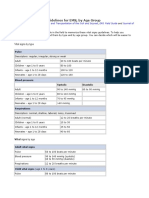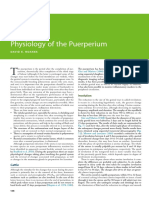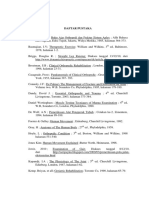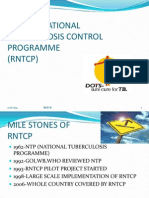Traffic Light System
Uploaded by
Erick PrasetyaTraffic Light System
Uploaded by
Erick PrasetyaClinical assessment tool for children 0-5 years
Traffic light system for identifying severity of illness
Only to be used in conjunction with pathways for gastroenteritis, bronchiolitis
and fever
Green – low risk Amber – intermediate Red – high risk
risk
Alert Miserable Difficulty waking
Responding normally to Not responding normally No response to social
social cues to social cues Clues
Behaviour Stays awake / Decreased activity Floppy
Activity awakens quickly
Content / smiles No smile Weak, high pitched or
continuous cry
Strong normal cry / Grumpy Appears ill to a health
happy professional
Temperature Normal ≥38 in 3-6 months olds ≥38 in under 3 months
≥39 in over 6 month olds ≥39 in 3-6 months olds
CRT <2 seconds CRT 2-3 seconds CRT over 3 seconds
Skin Normal colour skin, lips Pallor reported by Pale / mottled / ashen
(CRT on chest) and tongue parent/carer blue
Moist mucous membrane Dry mucous membrane Cold extremities
Reduced skin turgor
Cyanotic lips and
tongue
Periphery pulses weak
Respiratory rate Normal breathing Under 1 year ≥50 Under 1 year ≥60
(see table below) Over 1 year ≥40 Over 1 year ≥50
SATS in air 95% and above 92-94% <92%
Chest recession None Mild – moderate Severe
Nasal flaring Absent Occasionally present Constantly present
Grunting Absent Absent Present
Pulses/heart rate Normal heart rate Under 1 year <190 Under 1 year ≥190
(see table below) Over 1 year <160 Over 1 year ≥160
Normal – no vomiting 50-75% fluid intake over <50% fluid intake over
Feeding/hydration Normal urine output 3-4 feeds +/- vomiting 2-3 feeds +/- vomiting
Reduced urine output Significantly reduced
urine output
Apnoeas No apnoea Breathing slower than Frequent apnoeas
expected
CRT: Capillary Refill Time to be done on the chest; SATS: Saturations in air; Apnoea = 10-15 seconds
or shorter if accompanied by sudden drop in SATS or central cyanosis or bradycardia
*Temperature measured as per NICE guidelines (axillary up to 4 weeks old, ear thermoscan >4 weeks
Normal parameters Heart rate Mean resp rate For children 1 year and over
Infants <1 year 110-160 40 Estimated weight = (age in yrs +4) x2
Toddler 1-2 years 100-150 35
Pre-school 3-4 years 95-140 30
School 5-11 years 80-120 25
© Urgent Paediatric Care Pathway, RBFT Version 2.0 October 2016
Table 1
Symptoms and signs of specific diseases
Diagnosis to be considered Symptoms and signs in conjunction with fever
Non blanching rash, particularly with one or more of the
following:
Meningococcal disease - An ill looking child
- Lesions larger than 2mm in diameter (purpura)
- CRT >3 seconds
- Neck stiffness
- Neck stiffness
Meningitis1 - Bulging fontanelle
- Decreased level of consciousness
- Convulsive status epilepticus
- Focal neurological signs
Herpes simplex encephalitis - Focal seizures
- Decreased level of consciousness
- Tachypnoea measured as:
0-5 months – RR >60 breaths/minute
6-12 months – RR >50 breaths/minute
>12 months – RR >40 breaths/minute
Pneumonia - Crackles in the chest
- Nasal flaring
- Chest drawing
- Cyanosis
- Oxygen saturation <95%
- Vomiting
- Poor feeding
Urinary tract infection (in - Lethargy
children >3 months)2 - Irritability
- Abdominal pain or tenderness
- Urinary frequency or dysuria
- Offensive urine or haematuria
- Swelling of a limb or a joint
Septic arthritis/osteomyelitis - Not using an extremity
- Non-weight bearing
Fever lasting longer than 5 days and at least 4 of following:
- Bilateral red eyes
- Change in upper respiratory tract mucous membrane (e.g.
Kawasaki disease3 inflamed pharynx, dry cracked lips or strawberry tongue)
- Change in peripheral extremities (e.g. oedema, erythema or
desquamation)
- Polymorphous rash
- Cervical lymphadenopathy
CRT: capillary refill time
RR: respiratory rate
1
Classical signs (neck stiffness, bulging fontanelle, high-pitched cry) are often absent in infants with bacterial
meningitis.
2
Urinary tract infection should be considered in any child <3 months with fever. See ‘Urinary tract infections in
children’ (NICE clinical guideline, published August 2007)
3
Note: in rare cases, incomplete/atypical Kawasaki disease may be diagnosed with fewer features
This guidance is written in the following context:
This assessment tool is based on NICE guidance, which was arrived at after careful consideration of the
evidence available. Healthcare professionals are expected to take it fully into account when exercising clinical
judgement. The guidance does not, however, over-ride the individual responsibility of healthcare professionals to
make decisions appropriate to the circumstances of the individual patient, in consultation with the patient and/or
parents/carers.
You might also like
- Common General Practice Consultations - Notes For OSCEs89% (9)Common General Practice Consultations - Notes For OSCEs54 pages
- 350524main Optics Light Color and Their UsesNo ratings yet350524main Optics Light Color and Their Uses1 page
- 3.15 Febrile Child Under 5 Years Without A FocusNo ratings yet3.15 Febrile Child Under 5 Years Without A Focus8 pages
- cs50218 Nhs Fever Pathway For Remote Assessment in Primary Care Oct 19 v4No ratings yetcs50218 Nhs Fever Pathway For Remote Assessment in Primary Care Oct 19 v41 page
- CEM7213 Bronchiolitis Pathway Acute Care West Sussex Oct 2011No ratings yetCEM7213 Bronchiolitis Pathway Acute Care West Sussex Oct 20112 pages
- Techniques of Physical Assessment: Observation /inspection Palpation Percussion Auscultation100% (1)Techniques of Physical Assessment: Observation /inspection Palpation Percussion Auscultation56 pages
- Physical Examination and Restraint of CatNo ratings yetPhysical Examination and Restraint of Cat6 pages
- Guide For History Taking, Physical Exam and Diagnosis of Pediatric PatientsNo ratings yetGuide For History Taking, Physical Exam and Diagnosis of Pediatric Patients19 pages
- Two in One Disease: Asthma: Respiratory Disease That Can Have AttackNo ratings yetTwo in One Disease: Asthma: Respiratory Disease That Can Have Attack50 pages
- Apznzabuyifqyxfxvfewaduixp4nlcd7rqltsopbwaydxww5vzmvrn Fqdyjl 4ovwzyzezbcf82kwlrdq Zgkx1v2 Dofs Mmfmbce29ljhhe2kd6qz2x3zn Engb58mians8dtsvplx4izm4h Gwv2scw r0bmyktwv5zegdj4g9s Duxspj2oz1qjl4jsts23bumfy2p8gpwvzcjcxNo ratings yetApznzabuyifqyxfxvfewaduixp4nlcd7rqltsopbwaydxww5vzmvrn Fqdyjl 4ovwzyzezbcf82kwlrdq Zgkx1v2 Dofs Mmfmbce29ljhhe2kd6qz2x3zn Engb58mians8dtsvplx4izm4h Gwv2scw r0bmyktwv5zegdj4g9s Duxspj2oz1qjl4jsts23bumfy2p8gpwvzcjcx186 pages
- Management of Asthma Attacks in Childhood AsthmaNo ratings yetManagement of Asthma Attacks in Childhood Asthma43 pages
- Presentation Title: Arcilla-Beltran-Caagbay-LinaNo ratings yetPresentation Title: Arcilla-Beltran-Caagbay-Lina20 pages
- Introduction to Pediatric Nursing Nursing Care of High risk NewbornsinfantsNo ratings yetIntroduction to Pediatric Nursing Nursing Care of High risk Newbornsinfants6 pages
- (PESERTA) PEDIATRI 2 - MANTAP Februari 2017 PDFNo ratings yet(PESERTA) PEDIATRI 2 - MANTAP Februari 2017 PDF157 pages
- Common General Practice Consultations Notes For OSCEsNo ratings yetCommon General Practice Consultations Notes For OSCEs52 pages
- Snakebite Severity Score Flowsheet Algorithm PDFNo ratings yetSnakebite Severity Score Flowsheet Algorithm PDF2 pages
- Regulation of Vascular Tone: Role of 20-HETE in The Modulation of Myogenic ReactivityNo ratings yetRegulation of Vascular Tone: Role of 20-HETE in The Modulation of Myogenic Reactivity2 pages
- TEACHER-Made-Learners-Home-Task Nailcare 3No ratings yetTEACHER-Made-Learners-Home-Task Nailcare 34 pages
- Bahasa Inggris 2 Teknik Mesin Kamis 1-PM/2ME-A/B/2TPKM Dra. Mulyati Khorina, M.Hum. 4 90No ratings yetBahasa Inggris 2 Teknik Mesin Kamis 1-PM/2ME-A/B/2TPKM Dra. Mulyati Khorina, M.Hum. 4 905 pages
- Chapter 3 - Theories of Accident CausationNo ratings yetChapter 3 - Theories of Accident Causation44 pages
- Atrial Fibrillation Epidemiology, Prevention, and TreatmentNo ratings yetAtrial Fibrillation Epidemiology, Prevention, and Treatment33 pages
- Anterior Uveitis: A Manifestation of Graft-versus-Host DiseaseNo ratings yetAnterior Uveitis: A Manifestation of Graft-versus-Host Disease4 pages
- Patogenia de La Anemia Infecciosa EquinaNo ratings yetPatogenia de La Anemia Infecciosa Equina16 pages
- Infection Control and Prevention in DentistryNo ratings yetInfection Control and Prevention in Dentistry7 pages






























































































